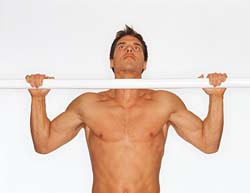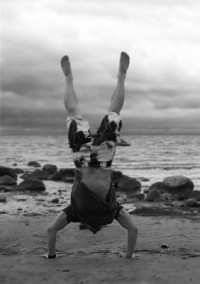 The pull-up is one of the most basic exercises - it’s simple. Just pull yourself up. However, its simplicity can be incredibly deceiving. I can’t recall the number of times I’ve seen a guy lifting really heavy weights and then struggling to get a few pull-ups. However, for building arms and back muscles and strength, the pull-up is a fantastic addition to your exercise repertoire.
The pull-up is one of the most basic exercises - it’s simple. Just pull yourself up. However, its simplicity can be incredibly deceiving. I can’t recall the number of times I’ve seen a guy lifting really heavy weights and then struggling to get a few pull-ups. However, for building arms and back muscles and strength, the pull-up is a fantastic addition to your exercise repertoire.
For a simple exercise, there are a few very different variations. The most common version is the simple dead-hang pull-up. Start hanging from the pull-up bar (ie. dead) and pull yourself up, pulling your chin up to slightly over the pull-up bar. Your grip can be either palm down or palm up. When performing pull-ups with the palm up, it is often referred to as a chin-up (or chin). It puts some additional focus on the biceps, but for the most part, either grip is suitable for a standard pull-up.
The width between your grip plays an important factor in difficulty. The wider your grip, the more difficult the pull-up will be and a greater distribution of work will be put on the back and triceps muscles.
The kipping pull-up (video courtesy of crossfit) starts the same way as its dead-hang counterpart, but instead of simply pulling yourself up from a dead hang, you use your full body to produce a force to help you up. This enables a greater number of pull-ups to be performed. Typically, gymnasts use kipping styles when on the rings. Kipping pull-ups are very difficult to perform properly, but once you get the hang of them, a set of 10 kipping pull-ups become simple. Kipping pull-ups could be added as part of a high intensity circuit style workout (5 sets of 10 kipping pull-ups, 10 push-ups and 20 air squats, done back to back).
After mastering the dead-hang pull-up, weighted pull-ups might be a consideration. Dangle a dumbbell from your feet or use some ties to tie a plate around your waist. This is an extremely advanced version of the pull-up that could cause injury if done incorrectly.
Leg raised (or L-Sit) pull-ups are dead-hang pull-ups done with the legs out in a hanging leg raise style, thus not only targeting the arms and back muscles but adding the abdominal muscles into the mix. Start with a standard dead-hang pull-up and raise the legs straight out in front of you. Now perform the pull-ups. You will find that on the way down, the force of stopping as the arms become fully extended puts an incredible amount of work on the abdominals. Definitely a great addition to a full-body workout.
If you can’t or have difficult performing any sort of pull-up, fortunately there is assistance to help you work yourself up to the standard pull-up. Jumping pull-ups start each pull-up with a jump. Start with arms extended to the pull-up bar and feet on the ground. If you cannot reach the ground, use a box or steps to allow your feet to touch the ground. Begin with a small jump to help yourself up to the chin-over-bar position. Work on the negative. In other words, lower yourself slowly from the chin-over-bar position. This will work the muscles well and help prepare you for a full non-assisted pull-up. Another assisted version requires the use of some additional gym equipment. Fortunately most gyms have these machines. They are called gravitrons. They usually have parallel bars at mid-level for assisted dips and pull-up bars at the top. Additionally, they have a pad on a set of rails and a stack of plates on a pully system, attached to the pad. The pad is for kneeling on. The stack of weights works counter to most other gym machines. As you use less weight on the gravitron, you are essentially using more of your body weight. Try setting the gravitron to 40lbs to start. Think of it as reducing your own body weight by 40lbs, making you lighter to pull up.


 The pull-up is one of the most basic exercises - it’s simple. Just pull yourself up. However, its simplicity can be incredibly deceiving. I can’t recall the number of times I’ve seen a guy lifting really heavy weights and then struggling to get a few pull-ups. However, for building arms and back muscles and strength, the pull-up is a fantastic addition to your exercise repertoire.
The pull-up is one of the most basic exercises - it’s simple. Just pull yourself up. However, its simplicity can be incredibly deceiving. I can’t recall the number of times I’ve seen a guy lifting really heavy weights and then struggling to get a few pull-ups. However, for building arms and back muscles and strength, the pull-up is a fantastic addition to your exercise repertoire.
